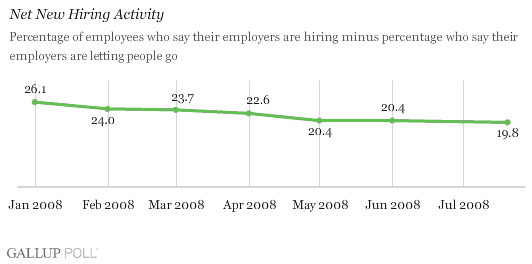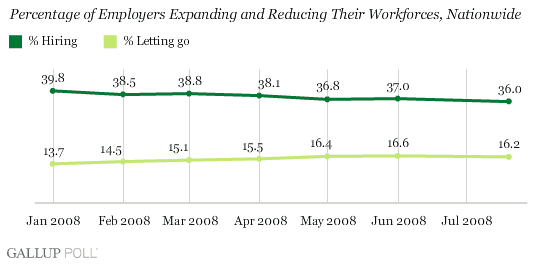PRINCETON, NJ -- In a sign that the economy continues to weaken even as the federal tax rebates have come to an end, Gallup's Net New Hiring Activity measure fell to 19.8 in mid-July -- down slightly from 20.4 in May and June. Net New Hiring Activity fell 2.2 percentage points from April to May and 1.1 points from March to April.

Job Market Conditions Continue to Weaken in Mid-July
On Wednesday, the Federal Reserve Board reported that consumer spending was sluggish or slowing in every region of the country. This is not surprising given all of the pressures currently buffeting the consumer, not to mention the end of the federal rebates. Nor should it be surprising that Gallup's Net New Hiring Activity measure shows employees reporting that the dismal conditions that characterized the labor market in May and June seem to have deteriorated further in mid-July.
Prior to the Fourth of July holiday, the Bureau of Labor Statistics reported that the U.S. economy lost 62,000 jobs in June and 438,000 for the first half of 2008 -- and that the unemployment rate stood at 5.5% in June. The decline in Gallup's Net New Hiring Activity measure -- based on a survey of more than 2,000 employees over the week of July 14-20 -- suggests that job market conditions continue to worsen and the economy continues to shed jobs for the seventh straight month. It also suggests -- barring a substantial drop in the number of Americans looking for work and a limited impact from seasonal adjustments -- that the unemployment rate may increase further in July, exceeding the 5.5% rate of the past two months.
Gallup's Net New Hiring Activity measure was initiated in January 2008. It is an effort to assess U.S. job creation or elimination based on the self-reports of more than 8,000 individual employees each month about hiring and firing activity at their workplaces. In order to calculate this measure, Gallup asks current full-time employees whether their employers are hiring new people and expanding the size of their workforces, not changing the size of their workforces, or letting people go and reducing the size of their workforces. Net new hiring activity is computed by subtracting the "letting go and reducing" percentage from the "hiring and expanding" percentage. The assumption is that employees across the country have a good feel for what's happening in their companies, and that these insider perceptions can yield a useful summary indication of the nation's job situation.
During the week of July 14-20, the percentage of employees saying their companies are hiring was 36.0% -- down from 37.0% in June -- while the percentage of employees reporting that their firms are letting people go was 16.2%, compared with 16.6% in June.

More Job Losses Seem Likely
Over recent weeks, Wall Street, the Treasury Department, and the Fed, as well as the president and Congress, have focused on a potential Fannie Mae/Freddie Mac financial crisis. Like the Bear Stearns debacle, the bailout of Fannie Mae and Freddie Mac is essential to the continued stability of the international financial system.
However, even as policymakers patch up the financial sector, the overall U.S. economy continues to weaken. And, while the federal rebates have masked this deterioration for a few months, they ended earlier this month. In this regard, Gallup's daily monitoring of employees' job market perceptions as reflected by Gallup's Net New Hiring Activity measure suggests that once the bailout of the two companies is completed, new attention may be focused on the next "shoe to drop": an increase in the unemployment rate and more job losses.
At this point, the economic slowdown/recession has been the result of everything from the housing market collapse to the surge in food and energy prices. However, economic conditions will weaken further if more Americans lose their jobs in the months ahead.
The recent sharp drop in oil prices provides some hope that gas prices will decline in the second half of this year and will help to boost the U.S. economy. On the other hand, this oil price decline -- like the decline in net new hiring activity -- may simply be another confirmation of the slowing global economy. Which interpretation is correct will unfold in the months ahead.
Survey Methods
Gallup is interviewing no fewer than 1,000 U.S. adults nationwide each day during 2008. The economic questions analyzed in this report are asked of a random half-sample of respondents each day. The results reported here are based on combined data of more than 8,000 interviews in January, February, March, April, May, and June. For results based on this sample, the maximum margin of sampling error is ±1 percentage point.
The questions for the third week of July are based on combined data of more than 2,000 interviews conducted July 14-20, 2008. For results based on this sample, the maximum margin of sampling error is ±3 percentage points.
Interviews are conducted with respondents on land-line telephones (for respondents with a land-line telephone) and cellular phones (for respondents who are cell-phone only).
In addition to sampling error, question wording and practical difficulties in conducting surveys can introduce error or bias into the findings of public opinion polls.
To provide feedback or suggestions about how to improve Gallup.com, please e-mail feedback@gallup.com.
